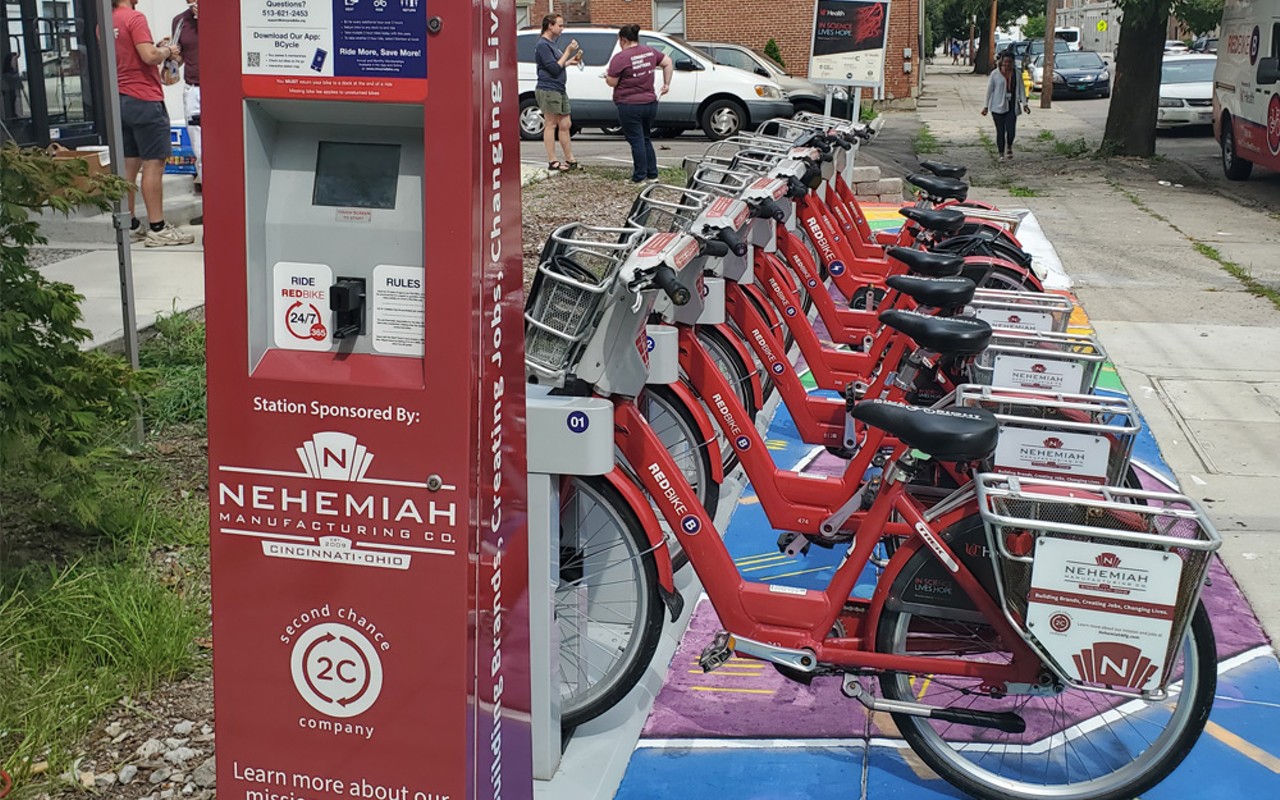Cincinnati’s Red Bike is one of five bikeshares across the country to win a “Living Lab” Grant from the Better Bike Share Partnership. Red Bike says the two-and-a-half-year, $200,000 grant will help them in their mission to grow equitable access via the Red Bike Go program. Red Bike will “develop and test innovative, new strategies and programs to increase access to bikeshare in the region,” says a release. Since 2018, Red Bike Go has offered a discounted $5 monthly membership to those with household incomes at or below 200% of the federal poverty guidelines. “Ensuring that everyone not only has access to Red Bike, but more importantly feels like Red Bike is actively catering to them has been a priority from day one,” says Jason Barron, executive director of Red Bike. “We are incredibly proud that the Red Bike Go Program is one of the best and most creative bikeshare equity programs in the country, and we cannot wait to see what we come up with over the next two-plus years.” cincyredbike.org.
With almost 24,000 followers, @cincinnati_revealed takes a photographic journey through the Queen City’s “architecture, art, anecdotal history and hidden gems,” per the account description. Photos of everything from Carl Strauss-designed modern abodes and newer Jose Garcia renovations to Italianate masterpieces and folksy Swiss Chalet-style homes dot the feed, with architecture quizzes on the stories. Read the captions for history, context and fun facts about each structure, which range from public buildings to private residences. @cincinnati_revealed.

Surprise: You’re here. Travel + Leisure magazine puts out an annual list of the best places to travel in the coming year — generally beautiful and exotic locales from across the globe. But this year’s compilation, titled the “50 Best Places to Travel in 2021,” did something a little different as a result of the pandemic: It listed the top places to visit right here in the U.S. The collection includes destinations like the Alaskan coast, Las Vegas, Tulsa, Oklahoma and all of the National Parks, but at No. 11 (it’s alphabetical — to our benefit) is Cincinnati. The write-up calls out Music Hall, the new Kinley Hotel (and its in-house eatery Khora), Please, Goose & Elder, the Cincinnati Zoo and the Cincinnati Art Museum, along with its new Art Climb.
Figuring out how to sign up for and receive the COVID vaccine has been a real clusterfuck — especially if you aren’t, or even if you are, tech-savvy — but every person on the other end of the line at the health departments of Norwood, Cincinnati and Hamilton County has been consistently helpful, kind and sympathetic while helping people register to get their shots. Shout outs to them.
The Hollywood Reporter says that actor/director/producer/hometown hero George Clooney plans to produce a docuseries about the sexual abuse scandal that has dogged Ohio State University for decades. The series will be based on an October 2020 Sports Illustrated story by L. Jon Wertheim that takes a deep dive into the abuse from 1978-1998, with many interviews from alleged victims. Ohio Congressman Jim Jordan has been repeatedly accused of looking the other way as Richard Strauss, then Ohio State’s team physician, sexually abused members of the wrestling team, for which Jordan was an assistant coach. Strauss also allegedly abused or raped students in other sports as well as non-athletes. Jordan has denied any involvement or knowledge of the abuse.
The Brent Spence Bridge reopened to traffic a day early (on Dec. 23) after a structure-damaging crash and fire in November closed both levels and required extensive repairs.
Hope you enjoyed getting into Northern Kentucky without an hour-long wait. In March, the Brent Spence Bridge again closed some of its lanes to traffic for almost the remainder of the year to complete some “maintenance.” The good news… well, there really isn’t any. The two westernmost lanes of the bridge — which the American Transportation Research Institute recently named the No. 2 bottleneck for freight trucks in the entire nation — will be closed during the first phase of the project, while the two easternmost lanes will remain open. During phase two, those will switch. In Ohio, the ramp to I-71 southbound from Fort Washington Way and the ramp to I-71 southbound from Third Street are both closed. Basically, if you’re in downtown Cincinnati, forget hopping onto southbound I-71. On the Kentucky side, the ramp to I-74/I-75 northbound is closed in Covington. During the closure, the Kentucky Transportation Cabinet will manage a maintenance project to clean and paint the bridge. The entire project is expected to last until Nov. 15.
Gov. Andy Beshear. The end.
Despite the fact mail is a proven and effective method of casting a vote (if not one that takes seemingly forever to tally), several concerns cropped up as millions of Americans took to the post-office box instead of the ballot box this presidential election as a result of the pandemic. There was a cluster of controversies around the U.S. Postal Service and the thorny question of whether its services were being crippled; concerns about equity; and at least one lawsuit calling out Ohio’s system that requires the signatures on absentee ballots match those on absentee ballot applications. In August, the Lawyers’ Committee for Civil Rights Under Law, the American Civil Liberties Union, the ACLU of Ohio and Covington & Burlington LLP filed an injunction against Secretary of State Frank LaRose to make sure that voters have “the opportunity, and sufficient time, to correct their mismatched signatures when boards of elections mistakenly reject their ballots and ballot applications on the basis of signature mismatches.” Jen Miller, executive director of the Ohio League of Women Voters, said, “Ohio’s unscientific signature matching processes create unfair electoral barriers, especially for senior citizens, youth, and voters with disabilities. Ohio needs to institute a transparent notice and cure process so voters can be assured their votes will count.” A federal judge said that while the signature verification process is burdensome, it wasn’t enough to change it before Nov. 3.
Two cemetery associations were founded in Cincinnati in 1844. Both created burial grounds that were revolutionary in their own ways, but the tales of these two cities of the dead are remarkably divergent. The Cincinnati Horticulture Society produced Spring Grove Cemetery, and the United Colored American Association created United Colored American Cemetery, later shortened to United American Cemetery. While Spring Grove set a new bar for graveyard design, United American became the first respectable burying ground for Black Cincinnatians — and the first Black cemetery in the State of Ohio. Today, Spring Grove is a source of municipal pride. It is the site of weddings as well as funerals. Its manicured beauty makes it a popular destination for leisurely walks or runs, and the cemetery offers guided walking tours. By contrast, United American looks derelict. But a piece of legislation could change the cemetery’s fate. Senator Sherrod Brown (D-OH) and Senator Lamar Alexander (R-TN) initiated a bipartisan bill, the African American Burial Grounds Network Act, which passed unanimously through the Senate this winter. The goal is to create a voluntary, nationwide network of historic African American burial grounds and allocate resources for their restoration and continued maintenance. Sen. Brown said on the Senate floor, “We know that for too long in too many parts of our country, Black families were blocked from burying their loved ones in white cemeteries. These men and women were freed slaves, civil rights champions, veterans, mothers, fathers, workers in communities. We need to act now before these sites are lost to the ravages of time or development.” The act now moves to the house. facebook.com/unionbaptistcemeteries.
According to the National Domestic Violence Hotline, intimate partner violence (IPV) affects more than 12 million Americans a year. And when much of the country was under stay-at-home orders at the start of the pandemic, it became clear that it was more difficult for victims of IPV to seek help or support — finding a private spot to call a hotline or the police is hard when isolating with an abuser; typical options for alternate places to stay were limited; and some in-person services were canceled. Locally, Women Helping Women — which offers “evidence-based prevention and expert crisis intervention and support services for survivors of dating violence, sexual violence, domestic violence and stalking” — immediately pivoted to accommodate the pandemic. WHW fast-forwarded plans to launch a new text chat feature, which allowed survivors to get ahold of the agency 24/7 without making a call; they started conducting virtual support groups for survivors; and moved one-on-one crisis management to teletherapy. At the time, WHW President and CEO Kristin Shrimplin said, “Some of the ways that services are being conducted may have to look a little different but anyone in danger and needing emergency services, that is still available to them” womenhelpingwomen.org.
During a February liveblog of weather updates around the country, cable news network CNN highlighted Gov. Mike DeWine’s proclamation declaring a state of emergency for Lawrence County, Ohio. The county had been hit hard by a recent winter storm, with ice, snow and debris causing dangerous conditions. That’s bad news, indeed. But it’s how CNN described Lawrence County’s location that captured our attention. “Lawrence County is about 144 miles east of the state capital, Cincinnati,” CNN posted. State capital. Cincinnati. DeWine didn’t include in his proclamation that Columbus had been stripped of its rank, unfortunately, so CityBeat hasn’t been able to confirm the Queen City’s new title. But we’re going to continue to believe it’s true for two reasons: we’re much better than Columbus, and cable news said so.
In 2020, the Hamilton County Board of Commissioners unanimously voted to make Juneteenth a paid holiday. Starting June 19, 2021, all county employees will have a paid day off. The resolution, introduced by Commissioner Victoria Parks, “recognizes the significance of Juneteenth to our country, county and community,” she said. The National Underground Railroad Freedom Center’s Christopher Miller provided historical context about the significance of Juneteenth during a commission meeting. “Juneteenth represents the end of chattel slavery in America. It serves as a historical milestone reminding Americans of the triumph of the human spirit over the systemic injustice of enslavement,” he said. “Juneteenth honors those ancestors who endured the institution of slavery as well as demonstrating pride in the great legacy of courage, resistance and perseverance — a legacy they left behind for us.” This past year also marked the first year the City of Cincinnati raised a flag commemorating the holiday.
Changes are coming to Cincinnati Metro in April that could save riders some dough while making others pay slightly more than they are now. Metro’s fare simplification plan goes into effect April 4 and will streamline the zone-based fare structure. The current fare structure is based on six zones of different fares, depending on where you’re traveling to or from. Under Metro’s new plan, zones will be eliminated, and fares will be simplified into three tiers: $2 for all local routes that operate inside of Hamilton County; $2.65 for all express commuter routes within Hamilton County; and $3.75 for all express commuter routes in Warren, Butler, and Clermont counties. Metro also will re-designate a number of routes from express to commuter service for a $2 one-way fare. These changes and others are part of Metro’s “Reinventing Metro” plan, which aims to incorporate faster service, increased frequency and other improvements for riders. go-metro.com.
Cincinnati Trump parades. This past year, thousands of locals adorned their cars with their flashiest Trump flair and took to the interstate to show their pride for the former President’s re-election bid. With patriotic embellishments safely secured to their vehicles, the hoard descended on I-275 — already an interminable traffic loop — and remained in the right-hand lane at a suggested speed of 50-55 miles per hour for the duration of their ride.
As essential workers, sanitation employees did their job while the rest of us were locked down and went above and beyond the call of duty — one in particular. While on his daily rounds in Colerain Township in January, Rumpke Waste & Recycling truck driver Aaron Kinsel stumbled across an unlikely surprise. After noticing something moving inside a backpack, Kinsel investigated the discarded bag and found a puppy. It’s unclear whether the 10-week-old pooch was thrown out intentionally, but Rumpke made sure the puppy made it to the vet to receive some much-needed care. As a result of his kindness, SPCA Cincinnati honored Kinsel with a Good Pet Samaritan Award. And the puppy, little Bunny FKA Tipper, found a forever home. rumpke.com.
This past summer, the Ohio Department of Health and Ohio Environmental Protection Agency teamed up with the U.S. EPA in Cincinnati and the Ohio Water Resources Center to test Ohio’s sewage and wastewater treatment systems to determine the presence of coronavirus RNA fragments in, well, poo. Fragments of coronavirus RNA can be found in the feces of both asymptomatic and symptomatic individuals infected with COVID-19. A study from the Scripps Research Translational Institute found that asymptomatic people have a similar viral load to those of symptomatic individuals, and up to 45% of infected individuals may be asymptomatic. According to a press release from the Ohio EPA, emerging science indicates that the virus can be detected in raw wastewater about three to seven days before there is a visible increase in cases and/or hospitalizations. So the data collected could provide an early warning of the virus’ spread in a community and indicate the level of spread.
On Dec. 30, Ohio Gov. Mike DeWine signed Senate Bill 27 into law, which basically says fetal remains from a surgical abortion must be either cremated or buried (by the abortion facility, or, under certain circumstances, the woman). Prior to the signing of the bill, fetal remains were already required to be disposed of “humanely.” But some felt that wording was too vague. Whichever way you feel, it’s now the law and The Satanic Temple has a few things to say about it — including that it’s unconstitutional. The temple’s Religious Reproductive Rights spokesperson Sydney Goodwin says, “This is an outrageous and unconstitutional affront to religious liberty. Ohio’s desire to dictate funeral procedures cuts at the heart of religious freedoms as these rites have been an essential component of religious practices for thousands of years.” The organization claims (quite logically) that the requirement infringes upon the temple’s First Amendment and religious freedom to request that fetal tissue “be incinerated with other medical waste.” The group has written up a medical exemption form that Satanists can bring to their abortion provider and Goodwin says the Satanic Temple is ready to fight the new law in court.
After all those years of sadly driving or biking by the tattered ruins of Warren County’s massive Peters Cartridge Factory, it’s now been beautifully transformed by the innovative, high-quality Bloomfield/Schon development company into a complex that has apartments, office space and a new brewery — the aptly named Cartridge Brewing.







